Subscribe to our ▶️ YouTube channel 🔴 for the latest videos, updates, and tips.
Telling Time in a.m. and p.m.
The clock shows time in 12 hour cycle. The first cycle of the hour hand completes at 12 o’clock midday or noon. The second cycle of the hour hand completes at 12 o’clock midnight.
‘a.m.’ and ‘p.m.’ are used to represent the time of the day.
‘a.m.’ stands for ante meridiem, which means before midday. Thus, ‘a.m.’ is used between 12 o’clock midnight to 12 o’clock noon. So, 7 o’clock in the morning is 7 a.m.
‘p.m.’ stands for post meridiem, which means after midday. Thus, ‘p.m.’ is used between 12 o’clock noon to 12 o’clock midnight. So, 7 o’clock at night is 7 p.m.
Use of a.m. and p.m.
When the hour hand goes around the clock once, 12 hours have passed. A day has 24 hours, so the hour hand goes around the clock twice in a day. (12 × 2 = 24 hours)
The clock will show two times in a day.
It is 12 o'clock. It may be 12 in noon or 12 at night.
So, how do we know whether it is 12 noon or 12 mid-night?
To show which part we mean, we use:
● a.m. for time after 12 mid-night and before 12 noon.
Thus, 6 a.m. means 6 in the morning.
● p.m. for time after 12 noon and before 12 mid-night.
Thus, 6 p.m. means 6 in the evening. 10 p.m. means 10 at night.
We do not write 12 a.m. or 12 p.m. We write 12 noon or 12 mid-night respectively.
I. Some activities are given below. Circle a.m. or p.m. for actions mentioned below.
(i) Eating breakfast
(ii) Going to School
(iii) Eating Dinner
(iv) Gazing Stars
(v) Playing Cricket
(vi) Good Morning
(vii) Good Afternoon
(viii) Sleeping
(ix) Shopping
Answer:
I. (i) a.m.
(ii) a.m.
(iii) p.m.
(iv) p.m.
(v) p.m.
(vi) a.m.
(vii) p.m.
(viii) p.m.
(ix) p.m.
II. Write the time using a.m. or p.m.
(i) 10:00 o’clock in the morning
(ii) 3:45 in the afternoon
(iii) 7:00 o’clock in the evening
(iv) 1:30 in the midnight
(v) 11:15 in the night
Answer:
II. (i) 10:00 a.m.
(ii) 3:45 p.m.
(iii) 7:00 p.m.
(iv) 1:30 a.m.
(v) 11:15 p.m.
III. Express the following in a.m. or p.m.
(i) Having breakfast
(ii) Studying at home
(iii) Going to school
(iv) Father returning from office
(v) Having dinner
Answer:
III. (i) a.m.
(ii) p.m.
(iii) a.m.
(iv) p.m.
(v) p.m.
IV. Use a.m. or p.m. to write a time shown in each clock.
Answer:
III. (i) 6:10 p.m.
(ii) 4:25 p.m.
(iii) 12:50 p.m.
(iv) 7:05 a.m.
(v) 4:10 p.m.
(vi) 7:25 a.m.
(vii) 9:10 a.m.
(viii) 10:05 p.m.
IV. Fill in the blank with a.m. or p.m.:
(i) Michael goes to play at 4:00 __________
(ii) Jessica school gets over at 2:30 __________
(iii) David's school opens at 7:00 __________
(iv) Anthony gets up in the morning at 6:00 __________
(v) Ashley eats her dinner at 9:00 __________
(vi) The sun sets at 5:45 __________
Answer:
IV. (i) p.m.
(ii) a.m.
(iii) a.m.
(iv) a.m.
(v) p.m.
(vi) p.m.
From Telling Time in a.m. and p.m. to HOME PAGE
Didn't find what you were looking for? Or want to know more information about Math Only Math. Use this Google Search to find what you need.
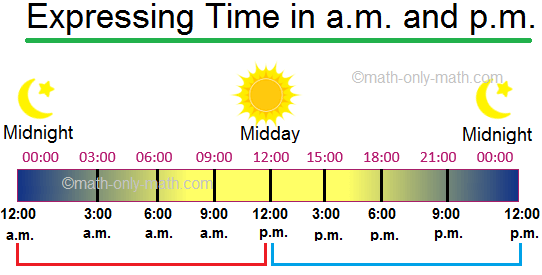
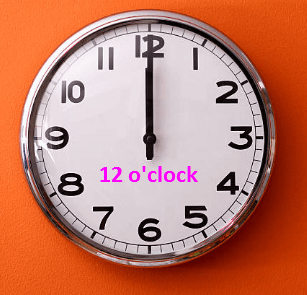
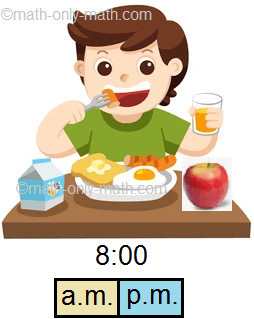
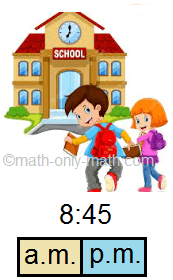
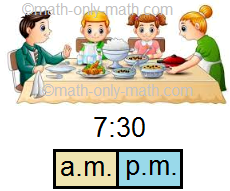
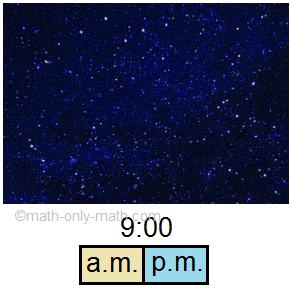
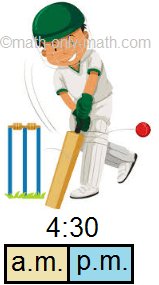
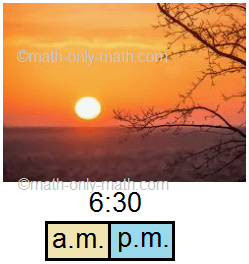
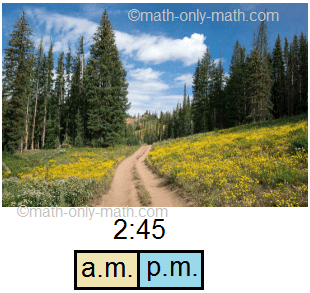
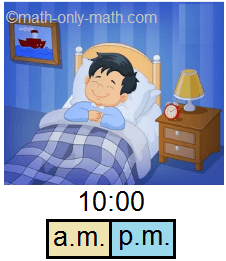

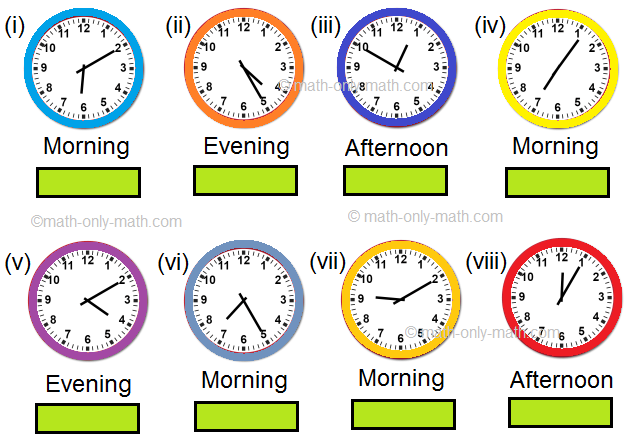


New! Comments
Have your say about what you just read! Leave me a comment in the box below. Ask a Question or Answer a Question.